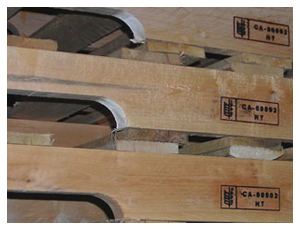Heat-treated, kiln-dried. Same thing, right? Not quite.
Confusion reigns over the subtle differences between the terms heat-treated (HT) and Kiln-dried (KD). This information is important as it has ramifications for HT ISPM 15 regulations. The HT ISPM 15 standard is in place to stop the spread of pests through international trade. Pests travel from country to country in the wooden pallets and crates used to transfer goods.
The key to identifying how HT and KD differ is to understand the two processes and the main aim of each one.

KD
Used to reduce the moisture content of lumber in a controlled environment (a kiln, for example) to reduce warping. Used mainly in the wood furniture and flooring industries.
HT
Essentially, pasteurization. The goal is to heat a product to a point of partial sterilization in order to eradicate living organisms (remember Louis Pasteur?).
For the purposes of wood-packaging materials (WPM) and the requirement to eradicate pest infestation, HT lumber must be heated to reach a core temperature of 56c for 30 minutes. With cherry and oak wood, it’s important to note that at this temperature sap will be released from within the wood. The sap will coat the wood with a dark stain, making the pallets or crates appear old and worn. In fact, the pallets and crates may actually be quite new and their strength or durability has not been compromised in any way by the HT process.
KD lumber can go through a variety of different processes, which is why pallets and wooden crates used for export must be stamped with the correct HT identification code to comply with the HT ISPM 15 standard. Check out this FAQ document from the Canadian Wood Pallet and Container Association for more details on HT ISPM 15. http://ctma.com/wp-content/uploads/WOODPACKAGINGFOREXPORT.pdf
There are two further links that discuss HT ISPM 15 regulations at the end of this article.
It’s also vital that the HT stamp (also known as the wheat stamp) is clearly visible on every pallet in a shipment. Should your shipment be inspected at a border crossing, and just one pallet is missing a wheat stamp or has one that is not legible, the whole shipment will likely be held. This will no doubt result in late delivery and likely incur additional unwelcome costs for you and your client.
Other advantages of heat treatment include:
• The reduction of moisture and weight to offer significant costs savings
• A stronger, more durable pallet
The current HT ISPM 15 exemption for WPM moving between Canada and the United States is set to expire in the near future. You will need to understand the complexities of the HT ISPM 15 regulations, or trust that your WPM supplier is compliant.
L.C.N. Inc. was the first company in North America to offer heat treatment for assembled wood pallets. With over 50 years of experience in the manufacture of wooden pallets and crates, we can supply you with all your packaging requirements.
Links
http://www.inspection.gc.ca/english/plaveg/for/cwpc/queste.shtml
https://www.ippc.int/index.php?id=1110798&tx_publication_pi1[showUid]=133703&frompage=13399&type=publication&subtype=&L=0#item